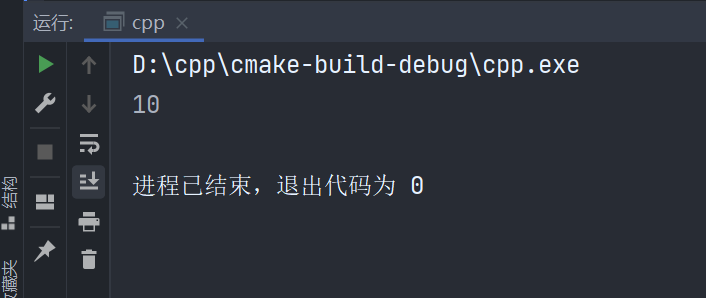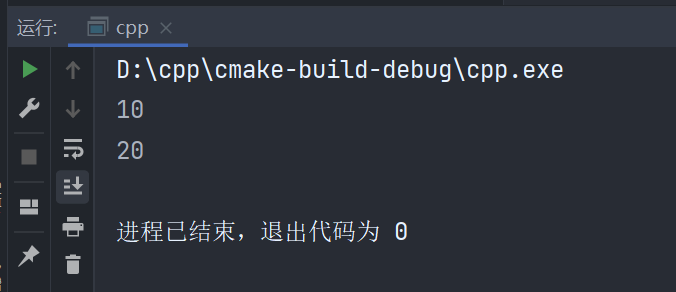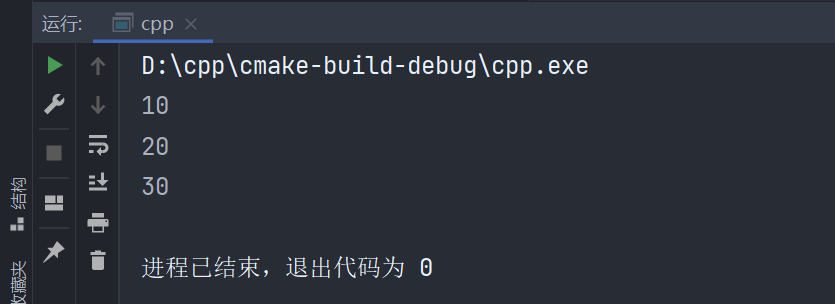1.通常的函数调用和通过函数指针变量调用函数
先看两段代码
//代码7.1
#include <iostream>
using namespace std;
void MyFun(int x);
int main()
{
MyFun(10);
}
void MyFun(int x)
{
cout << x << endl;
}
//代码7.2
#include <iostream>
using namespace std;
void MyFun(int x);
void (*FunP)(int );
int main()
{
MyFun(10);
FunP = &MyFun;
(*FunP) (20);
}
void MyFun(int x)
{
cout << x << endl;
}代码7.1的运行截图:

代码7.2的运行截图:

比较两段代码,结合前几篇笔记,发现MyFun好像是一个int型变量,FunP好像是一个int型的指针变量,这是我的感觉
2.调用函数的其他写法
说实话,看到这几种写法确实填充了我的知识漏洞,第一次知道可以有那么多调用方式
//代码7.3
#include <iostream>
using namespace std;
void MyFun(int x);
void (*FunP)(int );
int main()
{
MyFun(10);
//FunP = &MyFun;
FunP = MyFun; //新的写法
FunP(20); //还有这一行
//(*FunP)(20);
}
void MyFun(int x)
{
cout << x << endl;
}
//代码7.4
#include <iostream>
using namespace std;
void MyFun(int x);
void (*FunP)(int );
int main()
{
MyFun(10);
FunP = &MyFun;//注意新的写法
//FunP = MyFun;
FunP(20);//还有这一行
//(*FunP)(20);
}
void MyFun(int x)
{
cout << x << endl;
}
//代码7.5
#include <iostream>
using namespace std;
void MyFun(int x);
void (*FunP)(int );
int main()
{
MyFun(10);
//FunP = &MyFun;
FunP = MyFun;
//FunP(20);
(*FunP)(20);
}
void MyFun(int x)
{
cout << x << endl;
}以上所有代码均可以运行,且运行结果正确
另外:
//代码7.6
#include <iostream>
using namespace std;
void MyFun(int x);
int main()
{
(*MyFun)(10);//注意这行
}
void MyFun(int x)
{
cout << x << endl;
}注意与7.1代码的比较,发现调用MyFun函数又多了一种
总结思考:
1)其实,MyFun 的函数名与 FunP 函数指针都是一样的,即都是函数指针。 MyFun 函数名是一个函数指针常量,而 FunP 是一个函数数指针变量,这是它 们的关系。
2)但函数名调用如果都得如(*MyFun)(10)这样,那书写与读起来都是不方便和不习惯的。所以 C 语言的设计者们才会设计成又可允许 MyFun(10)这种 形式地调用(这样方便多了并与数学中的函数形式一样,不是吗?)。
3)为统一起见,FunP 函数指针变量也可以 FunP(10)的形式来调用。
4)赋值时,即可 FunP = &MyFun 形式,也可 FunP = MyFun。
3. 定义某一函数的指针类型
//代码7.7
#include <iostream>
using namespace std;
void MyFun(int );
void typedef (*FunType)(int );
int main()
{
MyFun(10);
FunType FunP;
FunP = &MyFun;//FunP = MyFun;也可以
FunP(20);
(*FunP)(30);
}
void MyFun(int x)
{
cout << x << endl;
}下面是程序运行截图

分析如下:
首先,在 void (*FunType)(int)前加了一个 typedef 。这样只是定 义一个名为 FunType 函数指针类型,而不是一个 FunType 变量。 然后,“FunType FunP;”声明一个 FunP 变量。 有了 FunType 类型后,我们就可以同样地、很方便地用 FunType 类型来 声明多个同类型的函数指针变量了。如下: FunType FunP2; FunType FunP3;
4. 函数指针作为某个函数的参数
我们先来看一段代码
//代码7.8
#include <iostream>
using namespace std;
void MyFun1(int x);
void MyFun2(int x);
void MyFun3(int x);
typedef void (*FunType)(int ); /* 2. 定义一个函数指针类型FunType,与1函数类型一致 */
void CallMyFun(FunType myfun,int x);
int main()
{
CallMyFun(MyFun1,10); /* 5. 通过 CallMyFun 函数分别调用三个不同的函数 */
CallMyFun(MyFun2,20);
CallMyFun(MyFun3,30);
}
void MyFun1(int x)/* 1. 这是个有一个参数的函数,以下两个函数也相同。 */
{
cout << x << endl;
}
void MyFun2(int x)
{
cout << x << endl;
}
void MyFun3(int x)
{
cout << x << endl;
}
void CallMyFun(FunType myfun,int x)/* 3. 参数 fp 的类型是FunType。*/
{
//(*myfun)(x);/* 4. 通过 myfun 的指针执行传递进来的函数,注意 myfun 所指的函数是有一个参数的。 */
myfun(x);//上面写法一样正确
}可以按照注释1-5的顺序进行分析
代码7.8的运行结果如下所示
10
20
30/* C指针笔记全部结束*/
/* 2021.11.18 */






















 487
487











 被折叠的 条评论
为什么被折叠?
被折叠的 条评论
为什么被折叠?








